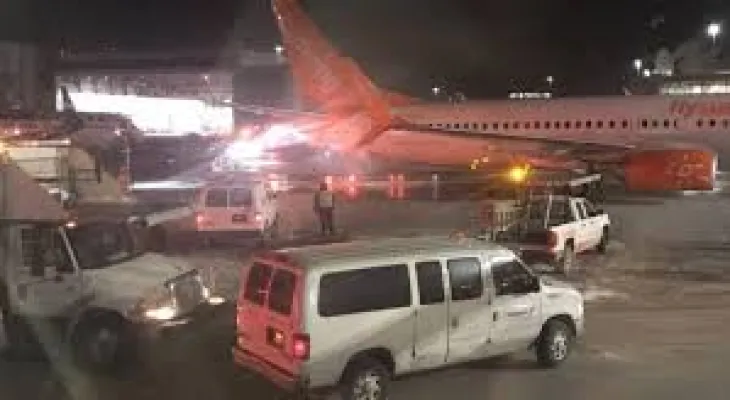Search here
Newspaper
Search here

Arab Canada News
News

Published: July 10, 2024
Major Canadian airports lack sufficient on-site resources to rescue passengers from inside aircraft in the event of a fire, according to firefighters who are urging the government to update local regulations to align with international safety standards.
The International Civil Aviation Organization (ICAO), which sets global aviation safety standards and is based in Montreal, states that in emergencies, airport firefighters must rescue aircraft passengers "as quickly as possible."
However, Canada’s Transportation Agency assigns airport firefighting crews "the primary responsibility of providing a fire-free exit route for evacuating passengers and crew," noting that this standard is not intended to restrict first responders from providing additional services.
In practical terms, staffing levels mean that airport firefighters need to wait for reinforcements from municipal firefighters to rescue aircraft passengers, according to Philippe Gagnon, president of the Montreal Airport Firefighters Association.
He added: "We will not be able to carry out the rescue operation within the timeframe required by international organizations. We will be able to extinguish the fire, but then we will have to wait before entering the aircraft."
There are fears that this waiting could cost lives, "the risk of death is present."
Passenger safety is compromised "unnecessarily."
The government is exploring the issue but has declined to commit to a specific outcome.
In December, the House of Commons approved a private member's motion put forth by Liberal MP Ken Hardie urging the government to update Canadian aviation regulations, warning that "significant regulatory shortcomings" "put the safety of air travelers at unnecessary risk."
Raising Canadian regulations to international standards would require including rescue and firefighting operations within the mandate of firefighters at major airports in Canada; enforcing a response time of no more than three minutes for firefighting rescue equipment to reach any point on the runway; and specifying the number of personnel required to meet firefighting rescue standards, according to the proposal.
After the motion passed, Transport Minister Pablo Rodriguez told the transportation committee that the government is "considering the potential financial, operational, and security implications of the proposed changes to Canadian aviation regulations."
But he wrote in a letter sent in May, which was obtained by the CBC network: "At this time, we cannot commit to a specific outcome."
Rodriguez was not available for further comment.
Minimum standards vary
Assigning airport firefighters the responsibility of rescuing passengers from inside the aircraft would require higher staffing levels at many Canadian airports.
The International Civil Aviation Organization's guidelines specify minimum staffing levels needed to operate rescue equipment - 10 firefighters to operate four fire trucks, for example. Fire safety standards set by the National Fire Protection Association based in the United States indicate that an airport the size of Montreal, Toronto, or Vancouver should have at least 15 airport firefighters on duty at all times, while an airport the size of Ottawa should have 12 firefighters.
Canadian airports meet the minimum local standards, according to airport spokespeople, but do not meet these higher international regulations.
An Ottawa airport spokesperson said there are at least four firefighters on duty, and five are the norm. A Toronto airport spokesperson said there are at least 11 firefighters on duty. Montreal airport declined to specify the minimum staffing levels, but Gagnon said five firefighters are scheduled, sometimes dropping to four.
Vancouver airport is the only one that comes close to international staffing standards, as a spokesperson said that between 12 to 19 firefighters are on duty at any time.
These minimum staffing levels are considered sufficient to operate fire trucks, but entering an aircraft requires additional firefighters. In emergencies, airport firefighting teams call for reinforcements from municipal firefighters.
Our Canadian aviation system is safe
This creates delays, according to Gagnon, who says that at Montreal-Trudeau International Airport, it can take an average of seven to 12 minutes to escort municipal firefighters to an incident.
He said response times at Ottawa Macdonald-Cartier International Airport can be slower, with local firefighters taking up to 15 minutes to arrive at the scene. An Ottawa airport spokesperson said response times vary.
A fire can engulf an aircraft in much less time than these delays, according to Chris Ross, president of the Montreal Firefighters Association and representative of the International Association of Fire Fighters. He added: "We can talk about evacuation and rescue, but there won't be any more evacuations or rescues" when these teams reach the scene.
Ross said municipal firefighters called to respond to an airport incident may not have completed necessary training for such emergencies, requiring them to "improvise."
A group representing airports says there is no cause for concern.
Monette Boucher, chair of the Canadian Airports Council, stated: "Our Canadian aviation system is safe."
And that "the responsibility for enacting these regulations lies with the government" and that airports are responsible for complying with them.
"We are following Canadian safety regulations, and safety is the backbone of everything we do."
Comments